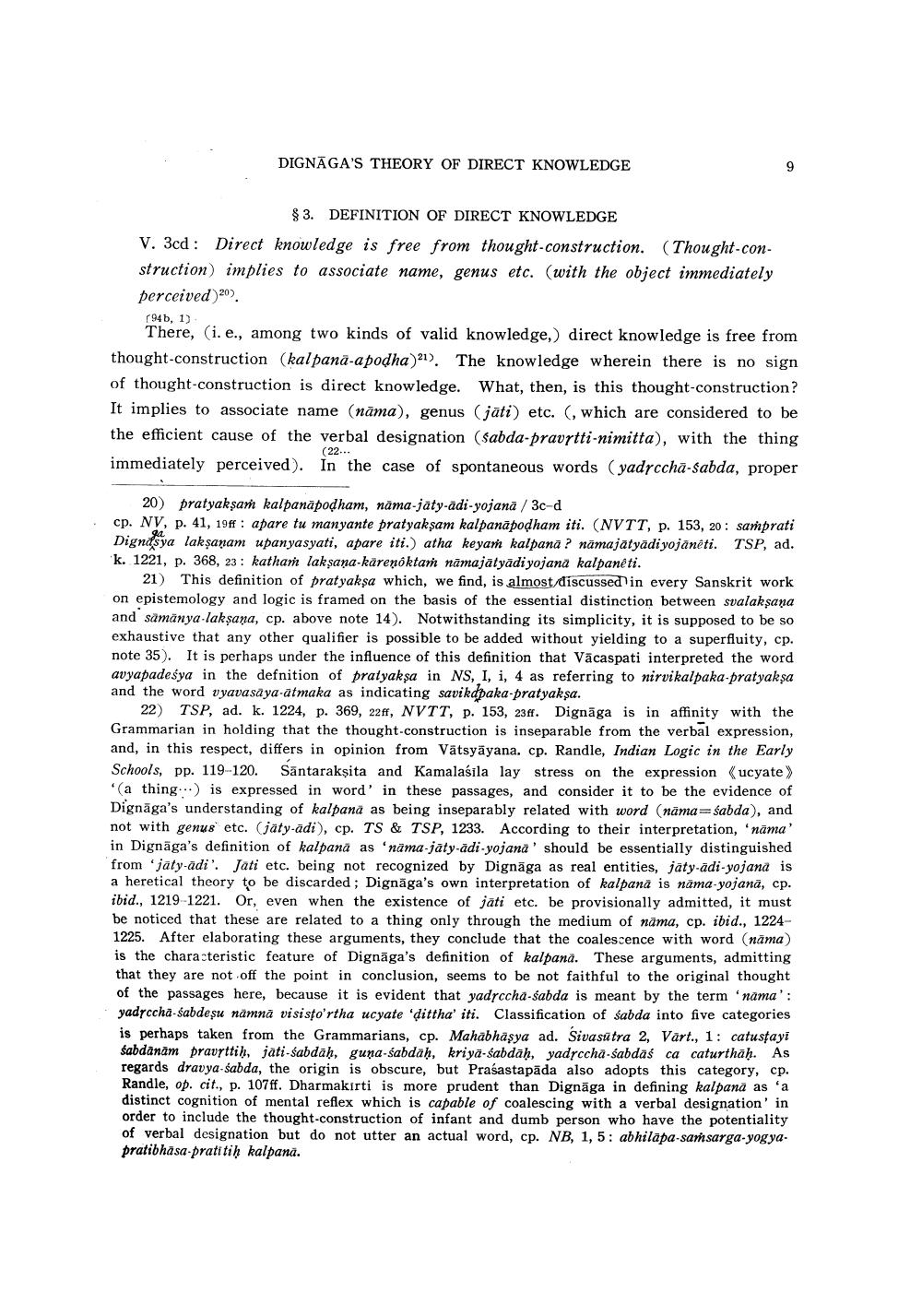Book Title: Dignagas Theory Of Direct Knowledge Author(s): Massaki Hattori Publisher: Massaki Hattori View full book textPage 9
________________ DIGNAGA'S THEORY OF DIRECT KNOWLEDGE $ 3. DEFINITION OF DIRECT KNOWLEDGE V. 3cd : Direct knowledge is free from thought-construction. (Thought-construction) implies to associate name, genus etc. (with the object immediately perceived)20). [94b, 1) There, (i. e., among two kinds of valid knowledge,) direct knowledge is free from thought-construction (kalpana-apodha)21). The knowledge wherein there is no sign of thought-construction is direct knowledge. What, then, is this thought-construction? It implies to associate name (nama), genus (jati) etc. (, which are considered to be the efficient cause of the verbal designation ($abda-pravytti-nimitta), with the thing immediately perceived). In the case of spontaneous words (yadrccha-sabda, proper (22 20) pratyaksam kalpanapodham, nama-jaty-adi-yojana / 3c-d * cp. NV, p. 41, 19ff : apare tu manyante pratyaksam kalpanapodham iti. (NVTT, p. 153, 20: samprati Digndsya laksanam upanyasyati, apare iti.) atha keyam kalpana ? namajatyadi yojaneti. TSP, ad. k. 1221, p. 368, 23 : katham laksana-karenoktam namajatyadi yojana kalpaneti. 21) This definition of pratyaksa which, we find, is almost discussed in every Sanskrit work on epistemology and logic is framed on the basis of the essential distinction between svalaksana and samanya-laksana, cp. above note 14). Notwithstanding its simplicity, it is supposed to be so exhaustive that any other qualifier is possible to be added without yielding to a superfluity, cp. note 35). It is perhaps under the influence of this definition that Vacaspati interpreted the word avyapadesya in the defnition of pratyaksa in NS, I, I, 4 as referring to nirvikalpaka-pratyaksa and the word vyavasaya-atmaka as indicating savikdpaka-pratyaksa. 22) TSP, ad. k. 1224, p. 369, 22ff, NVTT, p. 153, 23ff. Dignaga is in affinity with the Grammarian in holding that the thought-construction is inseparable from the verbal expression, and, in this respect, differs in opinion from Vatsyayana, cp. Randle, Indian Logic in the Early Schools, pp. 119-120. Santaraksita and Kamalasila lay stress on the expression (ucyate> '(a thing...) is expressed in word' in these passages, and consider it to be the evidence of Dignaga's understanding of kalpana as being inseparably related with word (nama=sabda), and not with genus" etc. (jaty-adi), cp. TS & TSP, 1233. According to their interpretation, 'nama' in Dignaga's definition of kalpana as 'nama-jaty-adi-yojana' should be essentially distinguished from `jaty-adi'. Jati etc. being not recognized by Dignaga as real entities, jaty-adi-yojana is a heretical theory to be discarded ; Dignaga's own interpretation of kalpana is nama-yojana, cp. ibid., 1219--1221. Or, even when the existence of jati etc. be provisionally admitted, it must be noticed that these are related to a thing only through the medium of nama, cp. ibid., 12241225. After elaborating these arguments, they conclude that the coalescence with word (nama) is the characteristic feature of Dignaga's definition of kalpana. These arguments, admitting that they are not off the point in conclusion, seems to be not faithful to the original thought of the passages here, because it is evident that yadrccha-sabda is meant by the term 'nama': yadrccha-sabdesu namna visi sto'rtha ucyate 'dittha' iti. Classification of sabda into five categories is perhaps taken from the Grammarians, cp. Mahabhasya ad. Sivasutra 2, Vart., 1: catustayi sabdanam pravrttih, jati-sabdah, guna-sabdah, kriya-sabdah, yadrccha-sabdas ca caturthah. As regards dravya-sabda, the origin is obscure, but Prasastapada also adopts this category, cp. Randle, op. cit., p. 107ff. Dharmakirti is more prudent than Dignaga in defining kalpana as 'a distinct cognition of mental reflex which is capable of coalescing with a verbal designation' in order to include the thought-construction of infant and dumb person who have the potentiality of verbal designation but do not utter an actual word, cp. NB, 1, 5: abhilapa-samsarga-yogya. pratibhasa-pratitih kalpana.Page Navigation
1 ... 7 8 9 10 11 12 13 14 15 16 17 18 19 20
